lec 24: ecosystems & global ecology
1/27
There's no tags or description
Looks like no tags are added yet.
Name | Mastery | Learn | Test | Matching | Spaced |
|---|
No study sessions yet.
28 Terms
humans
energy use accelerating & increasing
altered habitats
nutrient cycles disrupted
water
phosphorus & nitrogen
carbon
autotrophs are inefficient are capturing solar energy
0.8% incoming sunlight used by forest plants
45% GPP into production of new biomass; rest used to respiration/was lost
photopigments absorb fraction of light wavelength
enzyme efficiency is temperature dependent
warmer conditions → faster
dryer conditions → photosynthesis stalls
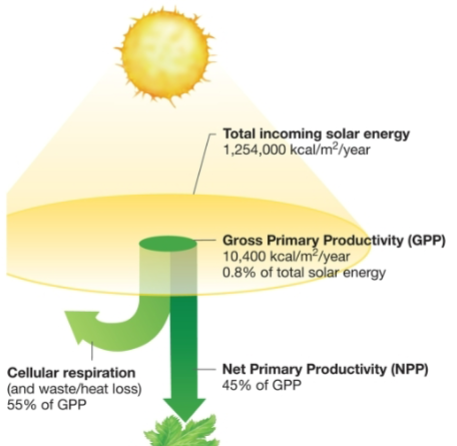
primary producers (autotrophs)
inorganic compounds → chemical energy stored in sugars
primary source of energy flow in ecosystems
gross primary productivity (GPP)
total chemical energy produced
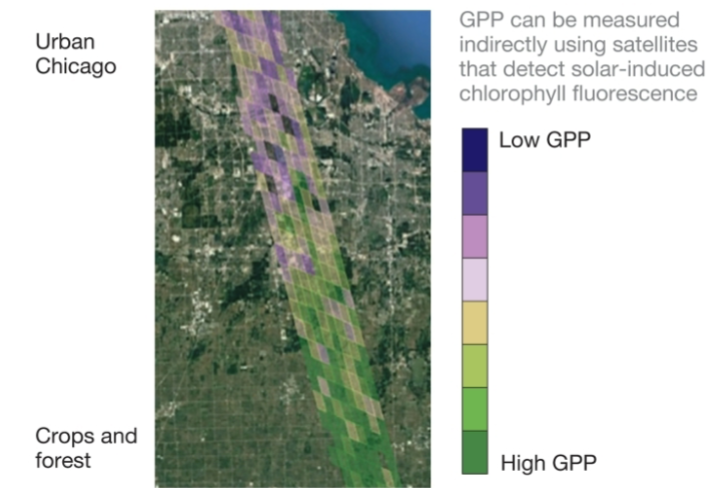
primary producers use GPP
GPP = R + NPP (NPP = GPP - R)
keep existing cells alive: cellular respiration (R)
growth & reproduction: NPP energy
biomass
total amount of chemical energy in organic material
net primary productivity among geographic regions
deserts = low NPP
forests (tropical wet) = high NPP & high productivity
net primary productivity among biomes
open oceans = low
majority of earth’s surface
topical wet forests = high
occupy modest amounts of earth’s surface
coral reefs = most productive
small surface area → limiting NPP contribution
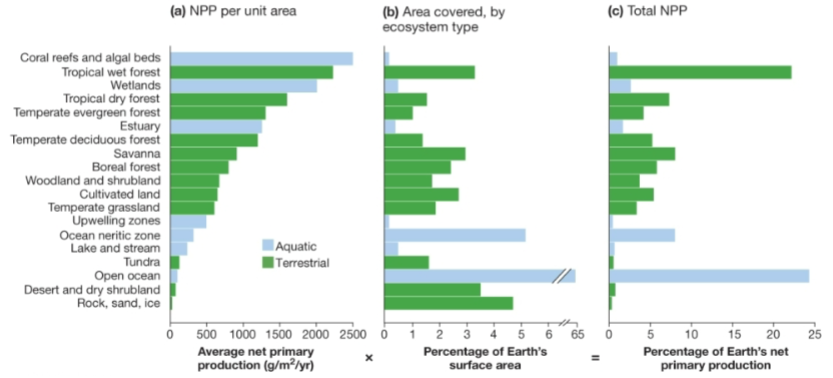
food chain
series of steps
molecules & energy travels
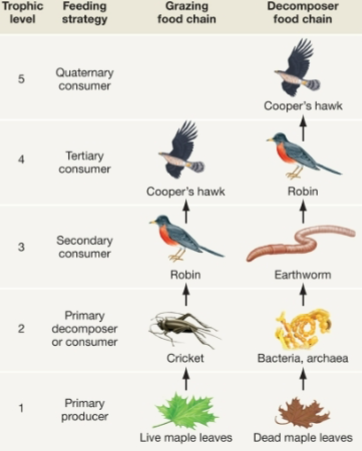
grazing food chain
herbivores (primary consumers) & organisms that eat herbivores
decomposer food chain
species eat dead remains
food webs
compact way to summarize energy flow & documents complex trophic interactions
nutrient cycle
energy eventually dissipates
sun replenishes energy
nutrients cycled through ecosystem
neither gained or lost
energy moves in form of biomass when organisms eat another
same energy source type = same trophic level (feeding)
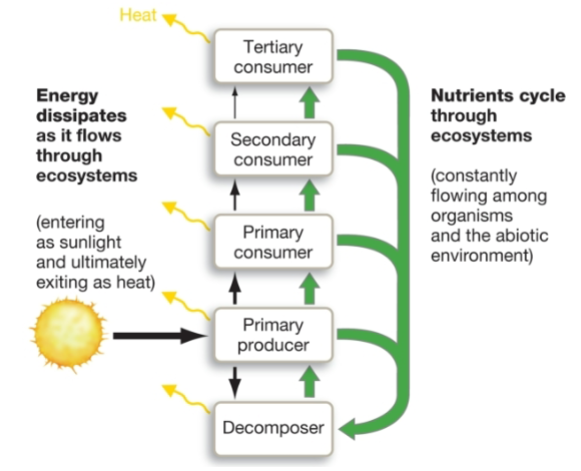
decomposers (detritivores)
feed on detritus (waste or dead remains)
productivity declines at higher trophic levels
biomass greater @ lowest trophic
biomass declines at higher levels
10% of energy transferred to next level

productivity pyramid
reports productivity & efficiency
productivity: biomass produced per unit of area yearly
efficiency: fraction of biomass transferred from one trophic level to the next
10% rule masks variation
large mammals: more efficient biomass producers
smaller surface-area-to-volume ratio & lose less heat
ectotherms: more efficient biomass producers
don’t rely on oxidized sugars to keep warm
rely on environment & spend less energy on cellular respirations
more efficient for humans to feed at lower trophic levels
humans as primary producers will receive the most energy due to one energy transfer

global water cycle
water evaporates out of oceans & precipitates over globe
water moves from lands to oceans via steams & groundwater (water in soil)
0.5% water in lakes, rivers, & groundwater for drinking
most groundwater in aquifers
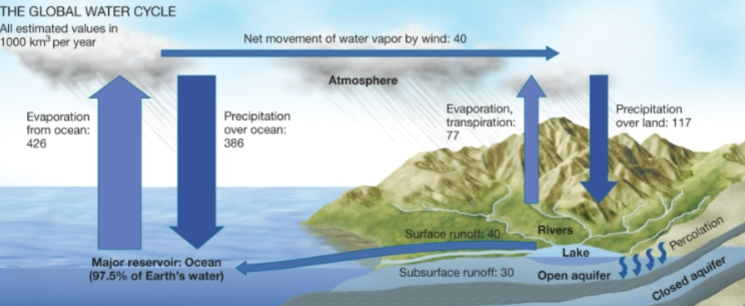
aquifers
layers of porous rock, sand, & gravel saturated with water
closed aquifers have nonporous rock layers & take thousands of years to recharge
open aquifers can be recharged by water percolating from surface
where humans extract freshwater
40% beyond carrying capacity
water table
upper limit of underground layer of soil saturated with stored water
global nitrogen cycle
nitrogen added to ecosystems is unusable when reduced or fixed
atmospheric (N2) → ammonia (NH3) from lightning-driven reactions & enzyme-catalyzed reactions in bacteria
plants only use fixed nitrogen
adding nitrogen increases productivity
too much is harmful
nitrogen pollution from burning of fossil fuels → acid rain, climate change, depletion of ozone layer
decreased species diversity
eutrophication: overfertilization → algal blooms in aquatic ecosystems → oxygen-free dead zones
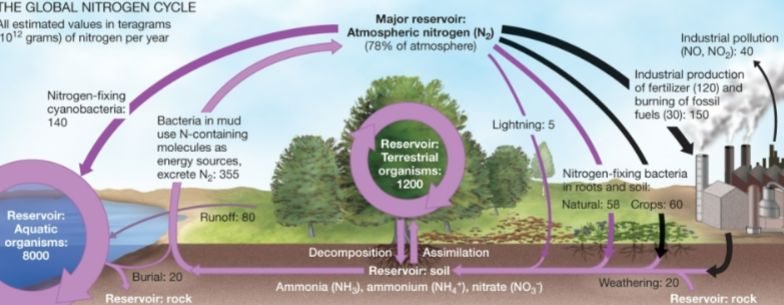
global carbon cycle
ocean is largest reservoir, atmospheric reservoir is small but important
photosynthesis incorporates carbon → tissue
cellular respiration releases carbon from living organisms → atmosphere
human activities add carbon dioxide to atmosphere
burning fossil fuels move carbon from inactive geological reservoir in petroleum or coal form → active reservoir
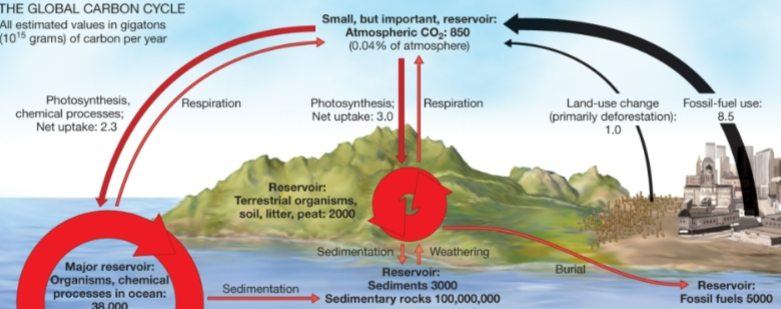
humans increase atmospheric carbon dioxide
cooking, heat, transportations, building, agriculture, manufacturing
energy comes from chemical sources in organic sources (wood, coal, oil, natural gas)
fossil fuels
vast reservoirs lock inside remains of plants that died mya
energy dense
easily burned to produce energy
collected in vast pockets accessible to us (coal, oil, gas)
yield carbon dioxide as waste product of combustion
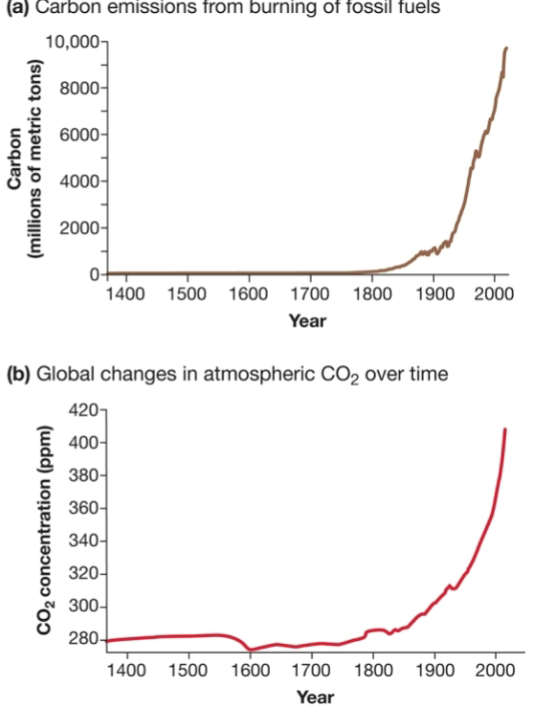
greenhouse effect explains atmospheric warming
CO2 is greenhouse gas
traps heat radiated from earth that would be lost to space
can be absorbed by ocean
increase in atmospheric CO2
greenhouse effect is natural consequence of CO2’s physical properties
greenhouse gases include methane (CH4), water vapor, & nitrous oxide (N2O)

overall rise in atmospheric CO2 & temperature, but not in solar radiation
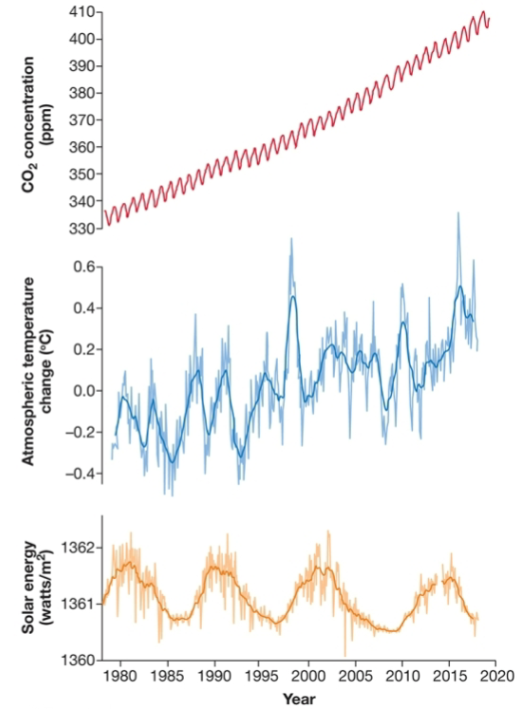
continued warming in the future
IPCC: 2017 temp exceeded pre-industrial levels by 1 C
increases of 1.5 - 2 degrees by 2100
0.5 - 7 by 2300
will be past 5 million over next 100 years
temp variation
polar regions increase more than tropics
ecosystems at same latitudes experience large increases
some seasons change more
temp extremes will increase
